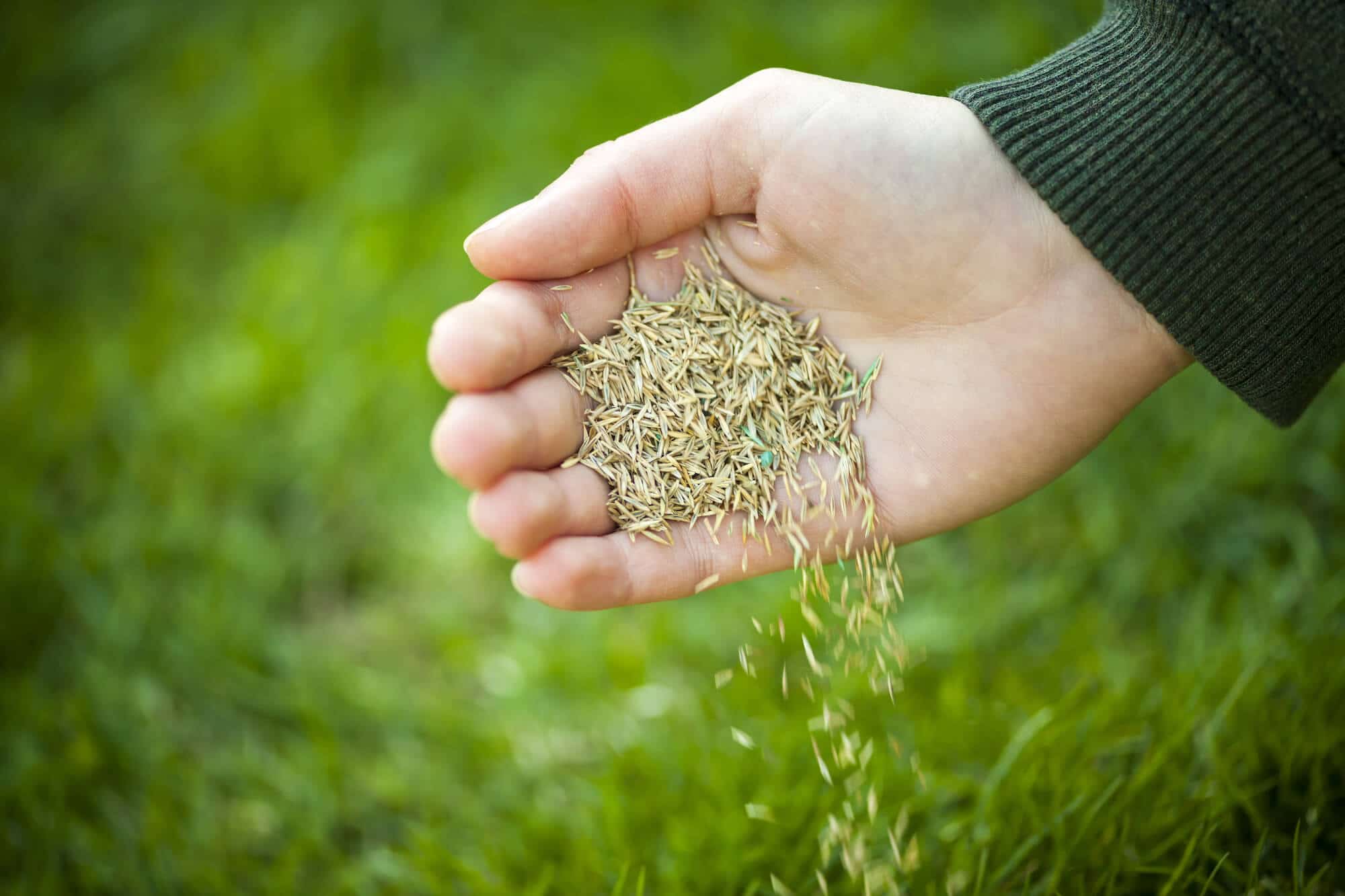Step-by-Step Guide to Overseeding a Lawn
For some homeowners, adding an extra layer of seed to a fully grown lawn may seem unnecessary. Why fix something that isn’t broken? However, professionals and experienced DIY lawn care buffs alike know that overseeding is often the key to achieving that lush and green lawn we all strive for.
Your turf deals with a lot during the year, especially in the winter. Extreme temperatures, pushy weeds, and even lawn fungus put it through the wringer, often causing the grass to thin over time. The thinner your turf, the more likely weeds, erosion, and soil problems can creep up on your lawn.
Every several years—or once a year if you want to go above and beyond—overseeding your lawn can help you achieve that lush lawn that catches the eye of every neighbor.

What is Overseeding a Lawn?
Overseeding is the process of spreading new grass seed across your current turf. It does not require complete removal of the other turf. The new seeds simply fill in the gaps where your turf needs extra fullness.
Homeowners and professionals will overseed their lawn for a variety of reasons, either to achieve greater color and fullness or to correct an area after lawn damage.
Like all good things, you can overseed too much or too often, creating too dense a lawn for even sunlight and water access. In most cases, however, a thinning lawn could benefit from a healthy overseeding after other issues have been addressed.
The Best Time of Year to Overseed
Overseeding is best performed when your grass is at its most active growing season. The best month will differ depending on both your region of the country and type of grass you have growing in your lawn.
When caring for your lawn, it’s important to know about the three primary hardiness zones in the US—the cool-season, warm-season, and transition grass zones.
Cool-Season Grass Zone
As you probably guessed, this area covers nearly the entire northern half of the United States and is the largest zone by far. This region primarily features grasses that can last through to the first frost of the year before going dormant during the winter. Popular cool-season grass varieties include:
- Kentucky Bluegrass
- Fescues (Tall fescue, sheep fescue, hard fescue, etc.)
- Ryegrass
- Creeping bentgrass
When to Overseed Cool-Season Grasses
The best time to overseed cool-season lawns is in the period between summer and fall. Your grass will begin to germinate around September, and adding seed at this peak moment will allow it to take root in a prime climate for building strong room.
If fall isn’t an option, early spring after the last frost is your next best bet.
Warm-Season Grass Zone
Head way down the southern coast and you’ll find lawns filled with warm-season grasses. These varieties cannot withstand the cool temperatures of the northern states, but thrive in the extreme heat of the southern summers. Since the temperature rarely drops enough to cause a frost, these grasses stay green far longer in the season. Some include:
- Zoysiagrass
- Centipedegrass
- Bermudagrass
- Carpetgrass
When to Overseed Warm-Season Grasses
Overseed your warm-season grasses in the late spring or early summer. This allows the seeds to take root right before the height of the season when the grass thrives in the extreme heat.
Transition Zone
Maintaining a thick and green lawn can be a bit trickier in the middle, especially in areas with high humidity in the summer and an occasional frost in the winter. In most cases, homeowners will combine both cool and warm-season grasses to ensure a stronger lawn.
However, grasses should be chosen down to your specific region’s annual climate. For example, soil pH, precipitation levels, chance of an early frost, and drought, are all important in choosing the right type.
When to Overseed Warm-Season Grasses
Overseed your lawn based on the variety of seed—or seeds—you choose. Take note of whether your selection is a cool or warm-season grass and aim for either the summer to fall transition or spring to summer.
Benefits of Overseeding Your Lawn
Overseeding goes beyond the cosmetic benefits of filling your turf with young, fresh grass. Diversifying the type of grasses in your lawn, or by simply adding a bit more to take root, you could end up with a far healthier lawn as well.
1. Discourage Pests and Disease
By mixing up your variety of grasses, you’re more likely to deter pests and build a balanced ecosystem that is resistant to problems. Certain grasses, especially when maintained in a supportive turf, will also survive with less frequent waterings, discouraging both pests and common fungi.
Without these main threats, there is less need to break out the chemical pesticides or fungicides, creating a far more eco-friendly landscape.
2. Decrease Erosion
Bare spots in your lawn will encourage both the wind and water to pick up soil and move it away from your lawn. Not only is this bad for your property, but it can also lead to pools of water that attract mold, pests, and soil density problems.
3. Leave No Space for Weeds
The most common weeds across the country have far stronger and larger root systems than your grass. Once weeds find a spot that they enjoy, they can quickly spread throughout a thinning lawn.
An overseeding lawn forces weeds to compete with the grass, choking them out as they grow. Like fighting pests and fungus, overseeding for weed control provides a much more reliable and chemical-free option for weed control.
How to Overseed: Step-by-Step
If you’re new to overseeding your lawn, hiring a professional can take away a lot of the guesswork. Choosing the right seed variety as well as dethatching and aerating can be tricky without the right tools.
However, if you’re aiming for the DIY approach, overseeding is very possible on your own with the right tools and tips.
1. Gather Tools and Materials
You will need three main things to properly overseed your lawn:
- Tools for prepping and spreading seed
- The right seed mixture
- Watering system for frequent lawn hydration
Most homeowners use a manual seed spreader that can be rolled and pushed like a standard mower. The seed is added to the basin of the spreader and a dial allows you to choose how much seed comes from the machine as you push. Ideally, the seed spreader sends seeds out an even coat to encourage a uniform look.
Depending on the state of your lawn when you begin, you may also need tools to aerate and dethatch your lawn. These run the gamut from a hand-help dethatching rake to a powered verticutter that breaks up turf in larger lawns.
2. Dethatch and Aerate
In some cases, breaking up your soil allows the thin layer of seeds to properly reach the soil at the root level. Dethatching is the process of breaking up the layer between your leaves and grassroots. However, It is typically only necessary if your thatch has grown beyond half an inch.
Aeration, on the other hand, is ideal for highly dense soil. This can happen when your soil becomes compacted or if it has a high percentage of clay.
If you do choose to aerate your soil, lightly rake your turf to more evenly distribute the cores of earth removed during the process. Otherwise, the seeds may slip into these premade holes and cause the grass to grow unevenly in these areas.
3. Mow Low and Clear the Clippings
In any other case, we wouldn’t advise you to remove the grass clippings after a thorough mowing. However, it’s important to make as much space for the new seed to reach the soil as its spread.
Also, your mower blades will also probably be set for the summer months, about three inches from the ground. Before overseeding, temporarily lower your blades an inch for a shorter cut, more typical of the late fall.
Be sure to raise your blades again afterward, especially for the first time you mow after overseeding.
4. Water Lightly
Moist soil is best for the overseeding process, but you do not want soil that is soaking wet. Too much water can cause the seeds to wash away entirely. If you want to ensure the right level of moisture, water the afternoon before you plan to overseed so the top layer of water has the opportunity to evaporate.
5. Spread the Seed Evenly
At long last, it’s time to spread the seeds in an even layer across your lawn. While each seed spreader will come with its one instruction, most work in a similar manner.
- Begin by adding the seed to the basin at the top of the spreader.
- Set the dial on the spreader to distribute the right amount of seed depending on the variety you choose.
- Most spreaders will come with an edge guard setting when working on the outside perimeter of your lawn. This setting should help you avoid inadvertently spreading seeds on walkways and patios.
- Begin on the outside of your lawn and toggle the spreader on when walking longways across your landscape.
- Remember to toggle the spreader off when turning to avoid the shorter edges of your lawn from accumulating too much seed.
- After you cover your whole lawn, return the remaining seed to its container.
6. Water Daily
Water your lawn with a soaking layer right after overseeding. Be sure that your soil remains wet down to an inch of soil for the full germination period, typically around 14 days. This will typically entail watering once a day—there’s no need to over soak your lawn during this phase.
7. Let Your Lawn Rest
As the new grass grows over the next 1-2 weeks, allow it to grow with minimal disruption from foot traffic or heavy machinery. Avoid mowing for the first two weeks so that the wheels of your mower do not overly compact your soil.
Since this is the peak growing season, your grass could look a bit unruly for a bit, but waiting for the new seeds to germinate will be worth the wait.
8. Fertilize
About six weeks after overseeding, apply the proper type of fertilizer for your seed variety. In some cases, a quick-release fertilizer is best for that extra boost of nitrogen. If you overseeded in the fall, however, a slow-release fertilizer will help your lawn prepare for the colder months ahead.
TruGreen Overseeding Services
Knowing when and how to overseed your lawn can be a bit of a guessing game without professional experience. By working with a professional team like your local TruGreen experts, avoid purchasing costly tools or running into confusion about seed varieties.
TruGreen offers overseeding throughout the US, particularly in several of its signature lawn care plans. Not only will these plans ensure that your lawn is lush and healthy, but they will also cover all the prep and overseeding maintenance that surrounds the process.
Whether you’ve just fought off a rough season of pests and fungus or are simply looking to bulk up the look of your lawn, speak with a TruGreen team member today. We offer free consultations and estimates based on your unique lawn, needs, and plans for your lawn.







